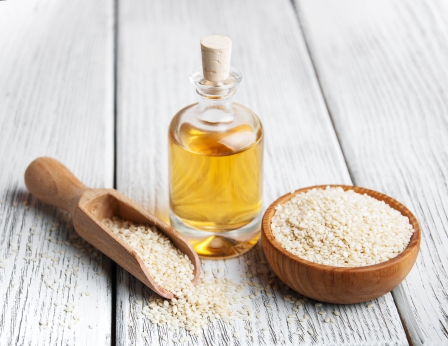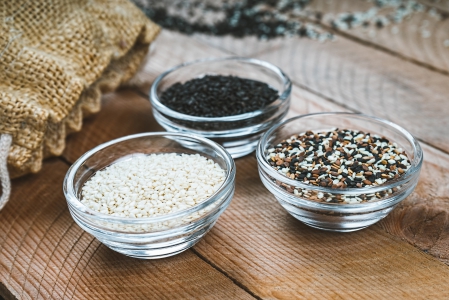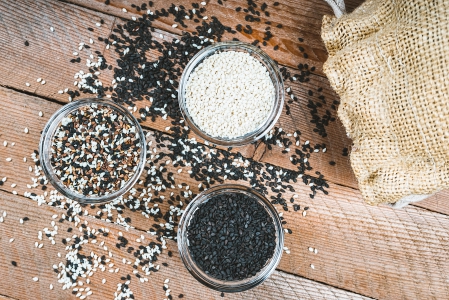Sesame is an important flowering plant of Sesamum genus and extensively cultivated for its seeds (edible) that grow in pods. Sesame seed is considered as one of the most nutritious food stuffs and is used for various therapeutic purposes.
Nutritional profile
- It contains significant amount of fat especially healthy fats like monounsaturated fatty acids, polyunsaturated fatty acids, omega-3-fatty acids, omega-6-fatty acids
- It contains various essential amino acids such as methionine, tryptophan and cysteine whereas it contains less amount of lysine
- It contains very less amount of carbohydrates but significantly high in fibre
- It contains several micronutrients like Vitamin A, Vitamin E, pyridoxine, niacin, thiamine, calcium, phosphorus, zinc, magnesium, manganese, copper and iron
- The most significant nutritional components of sesame seeds are considered as phytochemicals that are responsible for exerting antioxidant, anti-carcinogenic, anti-ageing, anti-inflammatory and antihypertensive effects. These compounds include sesamol, anthrasesamone F and sesamin. It also contains lignan and phytosterol that are associated with improving its utility
Type
It is mainly of two types, which include –
Black sesame seeds
- These are small, oily and flat seeds of Sesamum indicum plant
- Generally brownish to blackish in color
- They are comparatively richer in fibre, calcium and omega-3-fatty acid content than white sesame seed
- They are unhulled sesame seeds and comparatively bitter in taste due to the presence of hull

White sesame seeds
- These are also tiny oily seeds of Sesamum indicum plant, but these are hulled seeds and have an off-white color
- The color of white sesame seeds turns into brown when they are roasted
- White sesame seeds have comparatively higher oil content
Health benefits
Role on promoting bone health
- It is associated with enhancing bone mass, strength and promotes bone growth as it provides adequate amount of calcium
- It also helps to prevent the prevalence of arthritis and related bone disorders
Role on bowel health
- Fibre content of sesame seed helps to prevent constipation by improve bowel movement
- It helps to increase the mass of the stool and makes the stool soft hence helps in easy defecation
- It also improves digestion and absorption of foods
Role on skin
- Antioxidant activities of sesame seeds are responsible for providing proper nourishment to the skin that improves skin health, tone and elasticity
- It also helps to prevent ageing
- Application of sesame oil on skin is helpful for protecting the skin from UV radiation

Role on hair
- It has seen that sesame oil has potent antimicrobial activities and if applied to the scalp it helps to prevents scalp infections caused by several fungus and bacteria
- It helps to prevent dandruff
- It also helps to prevent hair loss
Role on metabolism
- Sesame seeds are a good source of B vitamins like thiamine, niacin, pyridoxine, which help to increase the activity of several metabolic enzymes by playing the role of cofactor (like TPP for thiamine, NAD+ or NADP+ for niacin, PALPO, PAMPO for pyridoxine etc.) and hence facilitate metabolic reactions of the body
- As its consumption helps to provide enough B vitamins hence it is closely associated with improving the metabolism and helps to prevent the prevalence of metabolic syndromes
Role on enhancing immune system
- Vitamin E, selenium, iron, zinc, copper and pyridoxine components of sesame seeds are responsible for improving immunological responses
- It is associated with enhancing the synthesis of WBC that helps to kill microbes (through phagocytosis) thus reduces the susceptibility of developing infectious and communicable diseases

Role on improving thyroid health
- Sesame seeds contain significant amount of selenium, which is an important trace element required for synthesizing thyroid hormones
- Consumption of sesame helps to stimulate the synthesis of thyroid hormones as it provides adequate selenium and it also provides copper, pyridoxine and zinc that also facilitates thyroid hormone production
Therapeutic advantages
Helps to prevent anaemia
- Sesame seeds contain various nutrients like iron, copper, pyridoxine which help in the synthesis hemoglobin that helps to prevent anaemia
- Consumption of sesame seed or any item prepared by sesame is very beneficial for reducing the harmful consequences of anaemia and hence should be consumed by adolescence girl, pregnant women and lactating women
Helps to prevent diabetes
- Sesame seed contains pinoresinol that helps to reduce glucose concentration within blood by inhibiting the activity of the enzyme maltase. It has seen that maltose (disaccharide, a type of carbohydrate) is digested by the enzyme maltase and produces glucose thus maltase inhibitory effect of pinoresinol is related with reducing blood sugar level
- It is also a low glycemic food, thus its consumption does not increase glucose load in blood after consumption
Helps to prevent hypertension

- Vitamin E, lignan and magnesium components of sesame seeds are responsible for preventing plaque formation within blood vessels that facilitates proper blood flow hence prevents hypertension
- It also helps to promote cardiac health
Role on regulating lipid profile
- Phytosterol and lignan components of sesame seeds have cholesterol lowering activities that help to maintain the level of cholesterol in normal range
- Unsaturated fatty acid contents of sesame seeds also help to reduce elevated cholesterol level within body hence decreases the prevalence of cardiac disease, obesity and diabetes
- It helps to reduce the concentration of triglyceride, LDL and VLDL, whereas improves HDL level
Helps to regulate hormonal balance during menopause
- Sesame seed contains phytoestrogen that functions similar with estrogen hormone. So, consumption of sesame seed may counteract the consequences of estrogen deficiencies especially among post-menopausal women
- It is also associated with reducing the prevalence of breast tenderness, breast cancers, hot flashes, mood swing and depression
Recent experiments
- Sesame seeds are considered as one of the important ancient oil seeds and current studies have shown that sesame seed powder is used as an alternative source of fat for milk. According to this research, fortification of sesame seed powder with low fat labneh (made up of skimmed milk) has shown thicker casein matrix formation and associated with improving organoleptic properties (Aly et al., 2020)
- Recent researches have shown that tamarind seed mucilage is considered as most significant wall material employed for oil encapsulation. Based on this research it has seen that the efficiency of microencapsulation of tamarind seed increases if it is protected from the oxidation of sesame oil (Alpizar-Reyes et al., 2020)

General consideration of using sesame seed
- We all know that protein is an important food constituent required for optimum growth and for maximizing the protein availability, it is better to choose hulled or roasted sesame seeds for consumption. These two processes (hulling and roasting) are accountable for decreasing the concentration of phytates and oxalates (which are responsible for inhibiting protein absorption) that enhances bioavailability of proteins
- It is better to roast the sesame seed for few minutes before consumption as it helps to increase its nutritive value
- Excessive consumption of sesame is not good for health as it may cause severe hypotension
- Consuming it in large amount also causes bowel obstruction due to its high fibre content
- It is better to consume sesame seed as per required amount and for maximizing nutrient intake one can consume roasted or sprouted or soaked sesame seeds

Source:
Alpizar-Reyes, E., Varela-Guerrero, V., Cruz-Olivares, J., Carrillo-Navas, H., Alvarez-Ramirez, J. and Pérez-Alonso, C., 2020. Microencapsulation of sesame seed oil by tamarind seed mucilage. International Journal of Biological Macromolecules, 145, pp.207-215.
Aly, A.A., Refaey, M.M., Hameed, A.M., Sayqal, A., Abdella, S.A., Mohamed, A.S., Hassan, M.A.A. and Ismail, H.A., 2020. Effect of Sesame Seeds powder with Different Ratio on Microstructural and Some Properties of Low Fat Labneh. Arabian Journal of Chemistry.
Jeong, S.M., Kim, S.Y., Kim, D.R., Nam, K.C., Ahn, D.U. and Lee, S.C., 2004. Effect of seed roasting conditions on the antioxidant activity of defatted sesame meal extracts. Journal of food science, 69(5), pp.C377-C381.
Pal, D., Chandra, P. and Sachan, N., 2020. Sesame Seed in Controlling Human Health and Nutrition. In Nuts and Seeds in Health and Disease Prevention (pp. 183-210). Academic Press.
Shahidi, F., Liyana-Pathirana, C.M. and Wall, D.S., 2006. Antioxidant activity of white and black sesame seeds and their hull fractions. Food Chemistry, 99(3), pp.478-483.
Shi, L.K., Liu, R.J., Jin, Q.Z. and Wang, X.G., 2017. The contents of lignans in sesame seeds and commercial sesame oils of China. Journal of the American Oil Chemists' Society, 94(8), pp.1035-1044.
Toma, R.B., Tabekhia, M.M. and Williams, J.D., 1979. Phytate and oxalate contents in sesame seed (Sesamum indicum 1). Nutrition Reports International (USA).
Wang, D., Zhang, L., Huang, X., Wang, X., Yang, R., Mao, J., Wang, X., Wang, X., Zhang, Q. and Li, P., 2018. Identification of nutritional components in black sesame determined by widely targeted metabolomics and traditional Chinese medicines. Molecules, 23(5), p.1180.



